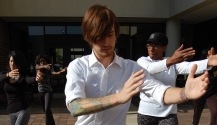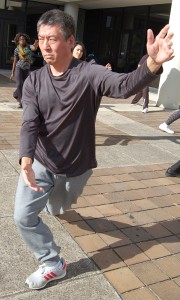

By Yao Seidu
It is just a thought.
But if the practice of Tai Chi — the most popular morning exercise in the world — were added to Georgia State’s men and women’s athletic program, it is possible that athletes would be healthier and discover a new sense of balance that adds agility and strength.
There is a warning here.
Tai Chi is difficult to learn and master, but scholars, physicians and researchers all swear there are many health, medical, physical and psychological benefits.
The exercise, described as “mediation in motion” by the Chinese among its population of 1.35 billion people, is known to strengthen, stretch, balance and coordinate the integration of the left and right halves of the body with the body core and its extremities.
“Tai Chi is a very particular kind of exercise that impacts the internal organs, rather than the muscles themselves,” said Tyler Purner, 23, a computer information systems student. “It’s not an easy class and requires a lot of homework.”
The art in motion
Georgia State students — non-athletes — who take Tai Chi classes twice weekly through the Department of Physical Therapy, only imagine the benefits that university athletes could achieve if exposed and trained to this Eastern exercise that includes choreograph movements and positions, some lasting 45 minutes.
Purner, no newbie to the long, continuous exercise, said, “I’ve seen Tai Chi previously, I never imagined that it would be this difficult. I didn’t know there was so much focus required to maintain balance and shifting your weight in the correct way. It is a workout.”
During this fall semester, Purner claims to have benefited from “improved balance and coordination” and has no plans to stop practicing Tai Chi.
“These are great skills to have. I would absolutely recommend this class to others, primarily for health benefits. I’m taking the class because I have a heart condition and I am hoping that Tai Chi — in time — will help strengthen it.”
The form at best
Tai Chi differs from a workout at the spa or gym in that the movements are usually circular and never forced. The muscles are relaxed rather then tensed; the joints are not fully extended or bent. Tai Chi is easily adapted to anyone from persons using wheelchairs to those recovering from surgery.
“It’s important to introduce Tai Chi at the university level,” said Fumin Xue, who teaches the single class of ‘Tai Chi: Therapeutic Exercise’ at Georgia State.
Xue, 50, born outside Shanghi, China, is also the executive director at the Taichihitos’s Health Science and Culture facility. He practices alternative medicine and came to Georgia State as a visiting scholar at the University’s Center for Integrative Healthcare Research.
Xue says Tai Chi has cured his 10-year stomach illness over the years.
“In China, it is common knowledge that this traditional exercise relieves chronic conditions, but that’s not well-known in the West,” he said. “Before the research studies and clinical trails in America and European medical facilities, the Chinese people knew that Tai Chi improves balance control for older adults; is good for cancer treatment, heart problems, fitness and wellness; and is good for almost all of the chronic conditions.”
The lifestyle for a journey
Marjorie Bennett, a thirty-something family nurse practitioner from Marietta, says Tai Chi is something she can incorporate in her fitness routine for the rest of her life, as Tai Chi trains her mind.
“Professor Xue says [our difficulties] are related to that part of our brains’ that are changing, and that is how Tai Chi works on our nervous system,” she said. “It is sort of reprogramming the synaptic in our brain to talk to each other a little bit better to help our memory to focus.”
Bennett says Tai Chi is almost like an aerobics or dance class with academic and didactic aspects integrated into the art.
“You have to keep up, it has been a challenge,” she said. “But, one that has been worth the undertaking.”
Continued from print.
Doing the homework
Anna Le, 24, a Californian from Vietnam, chose Tai Chi because the slow-motion exercise is different from what she is accustomed to.
“I’ve been into fitness all my life, I am very physical and I just wanted to let my body experience a different kind of fitness,” she said.
But the class was different from what she expected.
“I thought we would be sitting in a classroom more, and not actually being outdoors practicing, sweating and feeling our muscles tense up. It’s a good thing practicing and strengthening our white muscles,” Le said.
Le’s tips for success in the class: notes and diagrams.
“I can keep us in class because I break down the moves and identify where the mid-points are for each form,” she said. “I label them and that helps me to visualize the transitions to the next move, and it works. It is not easy, but the more practice, the easier it is for me.”

Long-term benefits of Tai Chi
There are several schools of thoughts relating to the health benefits and healing properties of Tai Chi. However, even the staunchest critics suggest that the benefits should be continuously explored, studied and tested at leading universities and medical facilities.
While the practice of Tai Chi is personally designed to age and harness appropriate movements, for Georgia State students they get to perform and memorize the most difficult forms in the martial arts arsenal.
Fifty million Americans 50 years and older have low bone density and experience great pain and medical expense from falls. Tai Chi is now being used successfully to improve the balance of older adults and arrest the rates of bone mineral density [BMD] decline.
Harvard physicians and scholars, along with thousands of others who practice medicine in America, are now calling Tai Chi an “adjunct medical treatment.”
Graduate student Rosalind Trusty, 51, of Stone Mountain is another Georgia State student taking Tai Chi for health benefits.
“I am enjoying it [Tai Chi] and it gives me balance in my exercise routine,” said Trusty, a physical fitness devotee. “I also do strength training and conditioning. I am really feeling a lot more muscle strength from Tai Chi which is helping me to perform in the gym.”
Five years out from knee replacement surgery, Trusty claims to have an improved mind and body connection when in the gym.
“It is not an easy class, I can’t just following along and commit [the forms and positions] it to memory, I don’t think anyone in the class can do that,” she said. “I find that I have to write down the steps — like many others in the class — and take it home to study.”
Trusty is not shy about recommending Georgia State Tai Chi to others.
“For an hour and 15 minutes, twice a week, this class gives you serenity and balance in your life,” she said. “Everything is gone from my mind except Tai Chi. It’s a stress reliever for me. Once I am done, I am a little bit lighter in the shoulders and I’m a little bolder in my walk. I just feel different in my spirit.”
